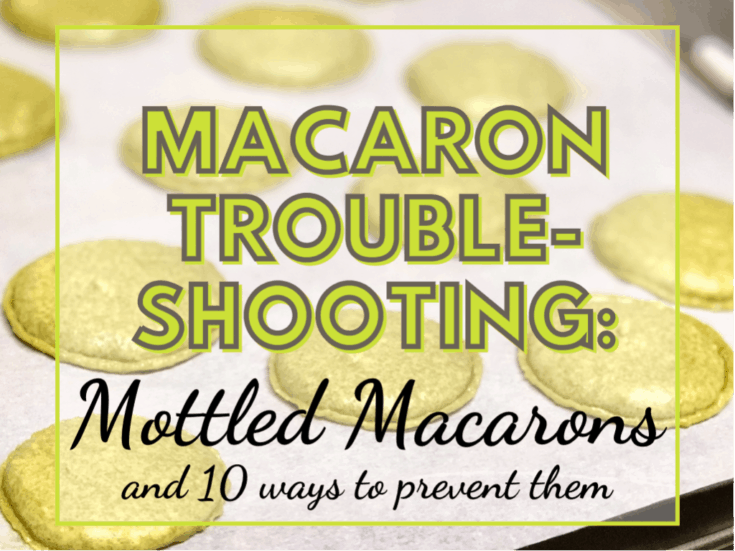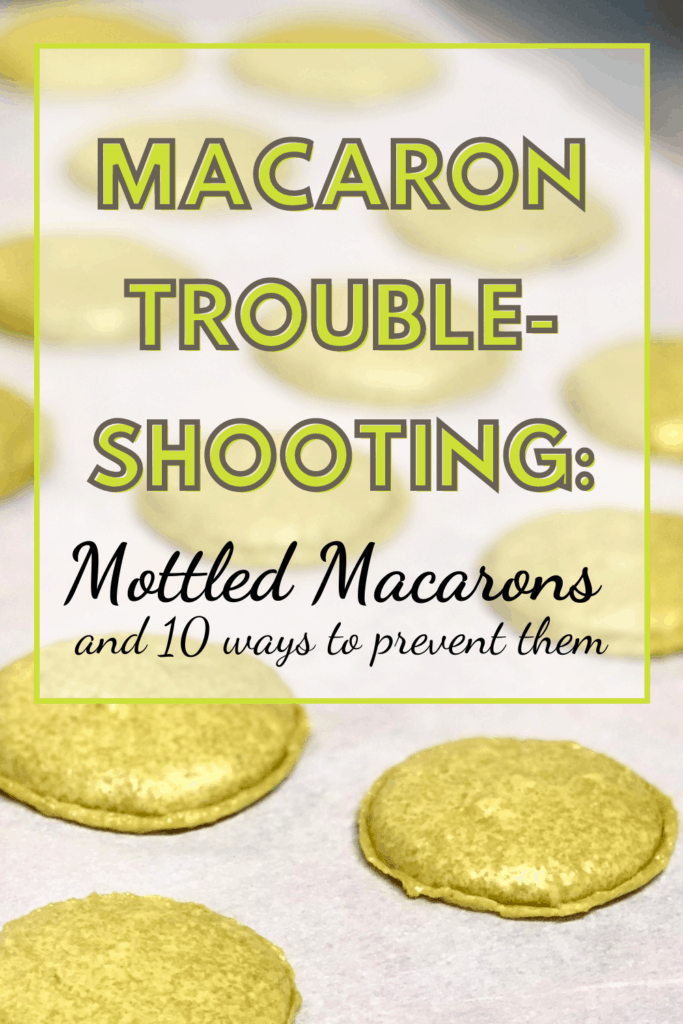Why are my macarons mottled and stained on top? Learn what causes it and ten ways to prevent mottled macs.
If you’d like to see other installments in the Macaron Troubleshooting Series, click here!
And for more mac fun join our vegan macaron community on Facebook!
WHAT ARE MOTTLED MACARONS?
Mottled macarons whose tops have darker colored spots and blotching. They look stained, like they’ve had water sprayed on them.
WHAT CAUSES MOTTLED MACARONS?
Macarons become mottled when either there is excess liquid (either oil or water) in the batter, or they were not baked high or long enough to sufficiently evaporate it out.
EXCESS OIL
Excess oil can come from three sources, and will make your macarons not only mottled, but hollow and the tops will be very fragile.
OILY ALMOND FLOUR
If your almond flour contains a lot of oil, there are a couple of things you can do to try and save it:
1. Dry it out in the oven. Spread your almond flour out on a clean baking sheet and pop it in the oven at around 200F (just under 100C). Bake it for 20 minutes and turn the oven off, and let it hang out in there for another 10 minutes before pulling it out and letting it cool.
2. Pulse it with your powdered sugar. This is less reliable than #1, but might help if you already have your oven preheated for the macarons or you don’t have time to wait for the almond flour to bake.
Simply put the almond flour and powdered sugar for your recipe in a food processor or blender and gently pulse until everything is combined well.
MAKE SURE TO USE VERY SHORT PULSES! If you hold that button down, you’ll release *more oils* and turn it into almond butter. Almond butter is delicious, but doesn’t make good macarons.
ADDED OILS
Many times the flavors people try to add to their macaron batter contain oil. Whether it’s lemon oil, peppermint oil, or something with naturally occurring oils like cinnamon or cocoa, these additives can wreak havoc on your macs.
The same holds true for colors. Make sure you are not using colors that contain oil! Candy colors made for chocolate will destroy your batter. Some natural colors like yellows that contain turmeric and greens with matcha can also cause problems.
If you’ve never made successful macarons before, you should leave out the flavors and colors until you can consistently make great batches. That way you know it’s the additive that’s causing the issues!
OIL FROM YOUR EQUIPMENT
If you use your silicone mats to make cookies, or your mixing bowl for buttercream, there’s a chance that some oil may have hung around on your equipment and sabotaged your macarons.
You should always wipe down all of your pans, mats, spoons, whisks, bowls, etc. with some vinegar prior to beginning the recipe to get rid of any residual grease that might deflate your meringue and doom your macarons.
Also beware of bits of buttercream falling from your mixer into the bowl!
EXCESS MOISTURE
If either your batter contains too much moisture, or it doesn’t have a chance to escape during baking, you could get mottled macarons.
INCORRECT MEASURING
One reason for this could be that the batter is too wet. This happens when your ratios are off.
Maybe you tried to estimate instead of measuring, or you’re using cups and spoons instead of weighing out the grams with a kitchen scale.
Even the best of us sometimes mess up too, though. It’s possible you accidentally added too much aquafaba (or water for folks who make potato protein macarons) or not enough dry ingredients.
This will also happen if you are making Italian macarons and didn’t heat the sugar up enough (which leaves extra water in it), or added too much color.

MERINGUE AND MIXING ISSUES
If your meringue is underwhipped or your batter is overmixed, it could also cause your macarons to be too saturated with moisture.
When you whip the meringue to stiff peaks, what you’re doing is creating billions of teeny tiny bubbles. It makes the batter light and airy, and allows it to dry out in the oven. If you don’t whip the meringue stiff enough, the bubbles aren’t there to allow moisture to escape easily.
Likewise, if you overmixed your batter during macaronage, you’ve popped all the bubbles you made during the meringue stage and the same problem arises.
Whip your meringue well and be sure you do not overmix your batter. It’s better to be too stiff and undermixed than to have mottled puddles for macarons.
HEAT PROBLEMS
Even if you did everything else right, when your oven is not hot enough it will cause your macarons to be too moist.
The oven temperature needs to be high enough to evaporate the moisture in the macarons before it has a chance to soak the outer shell of the cookie. It also needs to be hot enough to dry out the macaron before the meringue has a chance to deflate.
Anything lower than around 210F (100C) and sometimes even hotter than that depending on the batter and the weather will not dry out your macarons fast enough.
Chances are that if your tops are mottled, the macarons have no feet, and your macarons stick to your mat or paper, your oven wasn’t sufficiently hot.
BAKING TIME
Not baking long enough will also cause these problems.
Even if you vaporize the moisture in the outer parts of the shells with sufficient heat, if you don’t bake long enough the liquid will spread and settle on the surface. This will give them a mottled, stained appearance.
Under-baking will also leave your macarons raw on the inside, and they will be very fragile. Another sign that this is what has occurred is that they will stick to the mat.
If your macarons stick to the mat, become mottled AFTER baking, are raw inside, but have great feet, your oven was probably hot enough but the baking time was too short or you opened the door too much during baking.
CHECK YOUR FILLINGS
If your macarons baked perfectly with no problems, but become mottled after maturing, the culprit is your filling.
When you fill macarons with something very wet like jam or curd, the shells will absorb the moisture and become soaked and soggy.
Either switch the filling for something fat-based like buttercream or ganache, or give the bottoms of your macs a swipe of melted chocolate or frosting to make them waterproof before filling them.
MATURATION
If you mature them at room temperature, they can also over-mature after about 6-12 hours depending on the filling. Room temp maturation is good if you’re in a rush, but otherwise – keep it in the fridge.
TEN WAYS TO PREVENT MOTTLED MACARONS
Here is your checklist to make sure your macarons don’t come out mottled:
10 Ways to Prevent Mottled Macarons

Mottled macarons can be caused by plenty of different things, but here are 10 ways you can avoid them:
Instructions
1. Wipe down all of your equipment with vinegar before you begin.
2. Measure everything accurately by the gram with a good kitchen scale.
3. If making Italian macarons, make sure you bring your sugar syrup to the correct temperature.
4. Whip your meringue very well.
5. Do not add color or flavor with oils or meringue-deflating ingredients (if in doubt, leave it out!)
6. Do not let your batter sit for too long before piping (two hours max).
7. Make sure your oven is hot enough.
8. Make sure you bake them long enough and don't open the oven door.
9. Do not use very wet fillings without sealing your shells first.
10. Mature them in the fridge.

